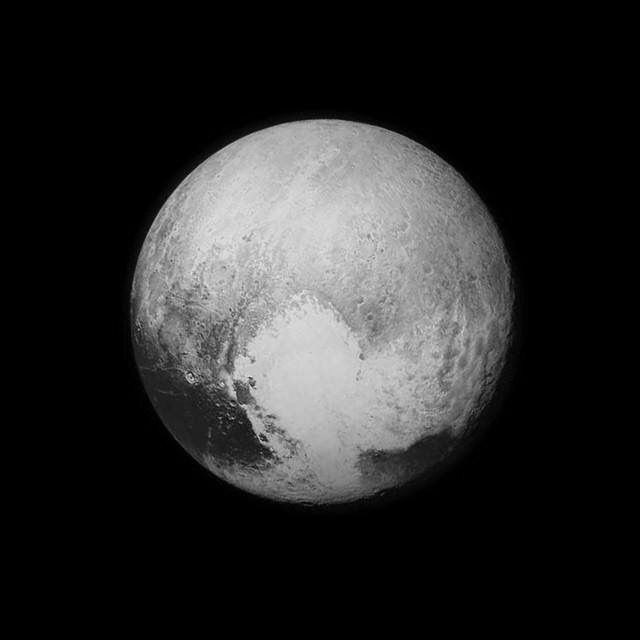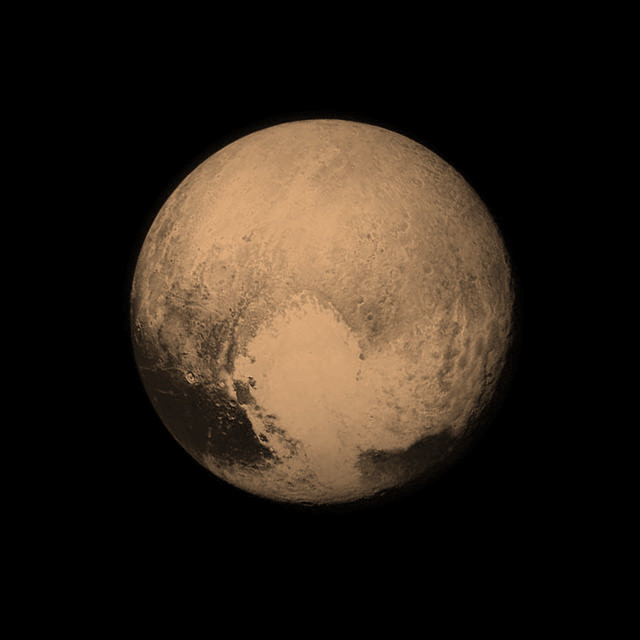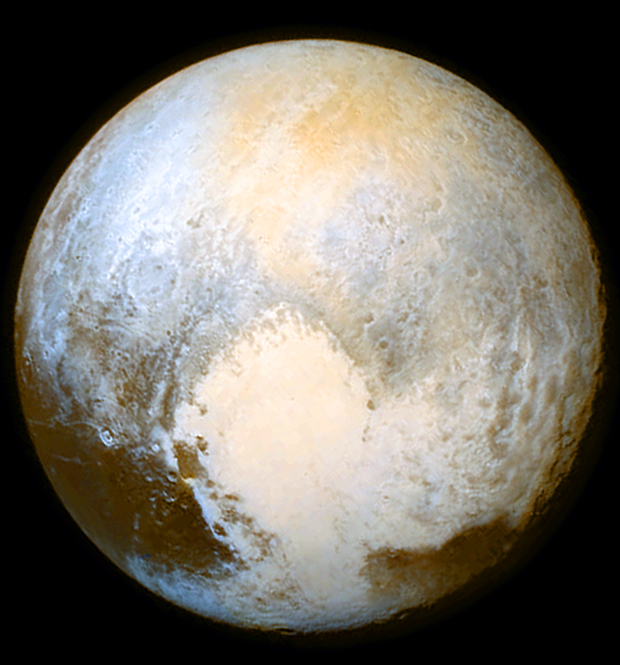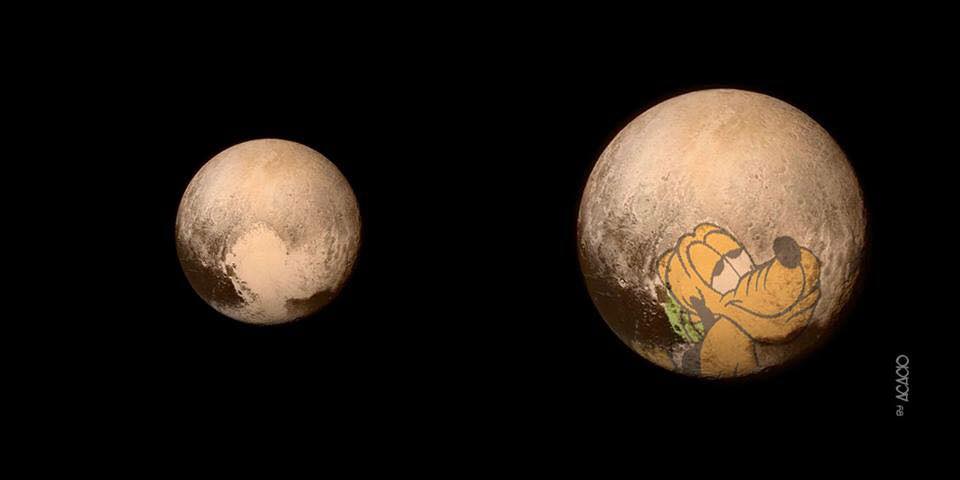It looks like you're using an Ad Blocker.
Please white-list or disable AboveTopSecret.com in your ad-blocking tool.
Thank you.
Some features of ATS will be disabled while you continue to use an ad-blocker.
share:
Cool picture.
I think I've found the entrance to inner Pluto where all the Plutonians live , or perhaps a Volcano ?

I think I've found the entrance to inner Pluto where all the Plutonians live , or perhaps a Volcano ?

originally posted by: baddmove
I found this picture.....
Just like the face on Mars on the Cydonia Plain, I suspect that an artificially constructed "Face on Pluto" would look like Plutonians...
...and we all know that image you posted on the right is exactly what Plutonians look like.
edit on 7/14/2015 by Soylent Green Is People because: (no reason given)
This is awesome !
Can't wait for more data to start streaming in.
Apparently by tomorrow morning, more pictures will start coming in, and as each day goes by the resolution is going to get closer and better. The technology on New Horizons is far better than what we had on the Voyager missions, so the pictures are going to be phenomenal !
Pluto... up close and personal.
Sweet !!
Can't wait for more data to start streaming in.
Apparently by tomorrow morning, more pictures will start coming in, and as each day goes by the resolution is going to get closer and better. The technology on New Horizons is far better than what we had on the Voyager missions, so the pictures are going to be phenomenal !
Pluto... up close and personal.
Sweet !!
It will take approximately 16 months from now until all the needed data has arrived due to the slow downlink to earth. So keep an eye out people, many
more pictures to come in the next months.
originally posted by: Mogget
Interesting fact........Pluto can come closer to Uranus in the present epoch than it ever can to Neptune, due to its 2:3 orbital resonance with the latter.
since Pluto is a dog its comes closer
to Uranus much more often than that.
sorry couldn't resist.
a reply to: Chadwickus
Is that a REAL color photo? Looks like desaturated photo that was colorified on top of it.
I've been following closer and closer pics of pluto and is this going to be the closest one can get or New Horizons will make closeups?
I wonder.. why didn't they just out a probe on New Horizons to land on Pluto and study the surface or see it from the ground, it's not like they can go to this dwarf planet any time.
Is that a REAL color photo? Looks like desaturated photo that was colorified on top of it.
I've been following closer and closer pics of pluto and is this going to be the closest one can get or New Horizons will make closeups?
I wonder.. why didn't they just out a probe on New Horizons to land on Pluto and study the surface or see it from the ground, it's not like they can go to this dwarf planet any time.
edit on 14-7-2015 by CollisioN because: (no reason given)
originally posted by: CollisioN
Is that a REAL color photo? Looks like desaturated photo that was colorified on top of it.
It's probably so dark there that you couldn't see Pluto with your own eyes if it was within arm's length of you, and that the color is blasted and enhanced as much as possible.
originally posted by: Blue Shift
originally posted by: CollisioN
Is that a REAL color photo? Looks like desaturated photo that was colorified on top of it.
It's probably so dark there that you couldn't see Pluto with your own eyes if it was within arm's length of you, and that the color is blasted and enhanced as much as possible.
The light is dimmer, but it's not that dark. The light on Pluto at noon would be about the same as the light on Earth a few minutes after sunset or a few minutes before sunrise.
Here's a webpage called "Pluto Time" from which you can calculate what time it would be in your location that would have the same brightness as on Pluto at noon.
Pluto Time
Here.. I just took the OP's picture, desaturated it to black and white -

tinted the black and white to a color of my choice (pale orange), increased saturation to 42 and got this:

I mean, the previous color pictures on NASA site from weeks looked more true color, this looks modified from colorless.
OK added a lil more red hue, played with curves and now looks closer (OP looks modified to me)


tinted the black and white to a color of my choice (pale orange), increased saturation to 42 and got this:

I mean, the previous color pictures on NASA site from weeks looked more true color, this looks modified from colorless.
OK added a lil more red hue, played with curves and now looks closer (OP looks modified to me)

edit on 14-7-2015 by CollisioN because: (no reason given)
originally posted by: baddmove
I found this picture.....
Good find, and that pic is probably making the rounds. An unexpected break for Disney with this picture and shape.
And now I can't look at the picture without seeing the Pluto outline. Even has a hint of the ear and the snout. Isn't coincidence fun!
edit on
14-7-2015 by Aleister because: (no reason given)
Unbelievable that we can see these clear pictures from a planet so far away. Interesting times indeed. ~$heopleNation
originally posted by: JadeStar
originally posted by: smurfy
originally posted by: JadeStar
originally posted by: smurfy
I'll tell you what...Pluto's a planet! Look how round it is, in that picture anyway.
Of course it's a planet. A dwarf planet, like Ceres. Roundness has nothing to do with whether something is a planet though. There are asteroids which are round. Comets in some cases are round, etc.
Roundness has to do with it in a considerable part, even in the new 2006 definition,
is in orbit around the Sun,
has sufficient mass to assume hydrostatic equilibrium (a nearly round shape), and
has "cleared the neighbourhood" around its orbit.
So no I wasn't being trivial, and in fact from this picture, Pluto is remarkably round, (apart from what looks possibly like a huge crater) given that it is thought to have a very weak gravity field.
Ok you're correct. I guess I should have said, "roundness isn't the only thing". It is important to note however, that while hydrostatic equilibrium is important in the 2006 definition, the one thing that is more important (which you pointed out) is having cleared the neighborhood around it's orbit. Pluto is a TNO, (Tran-Neptunian Object) and TNOs by definition haven't cleared their orbits.
There could be other things out there beyond Pluto which are round and have cleared their orbital neighborhood (i'd be willing to bet there's at least one) but until we're sure of that they won't be called planets.
To be fair then, shouldn't Neptune be demoted? I mean, if Neptune has not cleared its orbit of Pluto. . .
originally posted by: jaffo
originally posted by: JadeStar
originally posted by: smurfy
originally posted by: JadeStar
originally posted by: smurfy
I'll tell you what...Pluto's a planet! Look how round it is, in that picture anyway.
Of course it's a planet. A dwarf planet, like Ceres. Roundness has nothing to do with whether something is a planet though. There are asteroids which are round. Comets in some cases are round, etc.
Roundness has to do with it in a considerable part, even in the new 2006 definition,
is in orbit around the Sun,
has sufficient mass to assume hydrostatic equilibrium (a nearly round shape), and
has "cleared the neighbourhood" around its orbit.
So no I wasn't being trivial, and in fact from this picture, Pluto is remarkably round, (apart from what looks possibly like a huge crater) given that it is thought to have a very weak gravity field.
Ok you're correct. I guess I should have said, "roundness isn't the only thing". It is important to note however, that while hydrostatic equilibrium is important in the 2006 definition, the one thing that is more important (which you pointed out) is having cleared the neighborhood around it's orbit. Pluto is a TNO, (Tran-Neptunian Object) and TNOs by definition haven't cleared their orbits.
There could be other things out there beyond Pluto which are round and have cleared their orbital neighborhood (i'd be willing to bet there's at least one) but until we're sure of that they won't be called planets.
To be fair then, shouldn't Neptune be demoted? I mean, if Neptune has not cleared its orbit of Pluto. . .
Earth hasn't cleared its orbit of Earth-crossing asteroids or Earth's one known Trojan asteroid, or its Aten Asteroids (such as Cruithne).
edit on 7/14/2015 by Soylent Green Is People because: (no reason given)
originally posted by: 3danimator2014
I know i can google this but figured id get more interesting answers here, but does anyone know what kind of wavelength they are sending the data back on?
By the way, thanks for posting the image Chad!
They talk to the spacecraft at 7182 MegaHertz, and it answers at 8438 MegaHertz. These frequencies are in a range called the X band. The corresponding wavelengths are approximately 4.17 and 3.55 centimeters, respectively.
edit on 14-7-2015 by Ross 54 because: (no reason
given)
edit on 14-7-2015 by Ross 54 because: corrected capitalization error
a reply to: Chadwickus
That's a beautiful little planet .. finally we can see it from up close. .
Little brother of Mars ..
That's a beautiful little planet .. finally we can see it from up close. .
Little brother of Mars ..
Looks like a massive glancing impact in the lower part of the planet and then a string of impacts to the upper right hand side of them impact. Anyone
else thinking about Shoemaker-Levy 9?
Cool. That looks like heart at the bottom on that first pic
So is it a planet again? Always was and will be to me.
Amazing New Horizon Photo of Pluto...

(Sorry...had to do it.)
So is it a planet again? Always was and will be to me.
Amazing New Horizon Photo of Pluto...

(Sorry...had to do it.)
edit on 7/14/2015 by ~Lucidity because: (no reason given)
I've balanced the colours in PhotoShop and then increased saturation, to hopefully show the varied composition of the surface:

I think we can say that the bluish areas are frozen gasses like methane or CO, while the reddish areas are thick concentrations of hydrocarbon "sludge".
Compare this to the false-colour image from Ralph camera: www.nasa.gov...

I think we can say that the bluish areas are frozen gasses like methane or CO, while the reddish areas are thick concentrations of hydrocarbon "sludge".
Compare this to the false-colour image from Ralph camera: www.nasa.gov...
new topics
-
Paramilitary Leaks - John Williams
Whistle Blowers and Leaked Documents: 1 hours ago -
Some sausage, some chicken, some sauce, some onions and some garlic...and some peppers!
Food and Cooking: 2 hours ago -
Hearing more ambulances lately
Medical Issues & Conspiracies: 3 hours ago -
Los Angeles brush fires latest: 2 blazes threaten structures, prompt evacuations
Mainstream News: 3 hours ago -
House Passes Laken Riley Act
Mainstream News: 3 hours ago -
The more I think about it
General Chit Chat: 4 hours ago -
What Comes After January 20th
Mainstream News: 6 hours ago -
Canada as a state .. how would it work?
General Chit Chat: 6 hours ago -
Those stupid GRAVITE commercials
Rant: 7 hours ago -
Let's Buy Greenland
General Chit Chat: 8 hours ago
top topics
-
House Passes Laken Riley Act
Mainstream News: 3 hours ago, 21 flags -
What Comes After January 20th
Mainstream News: 6 hours ago, 17 flags -
Claim: General Mark Milley Approved Heat and Sound Directed Energy Weapons During 2020 Riots
Whistle Blowers and Leaked Documents: 12 hours ago, 12 flags -
Planned Civil War In Britain May Be Triggered Soon
Social Issues and Civil Unrest: 11 hours ago, 6 flags -
Let's Buy Greenland
General Chit Chat: 8 hours ago, 5 flags -
Those stupid GRAVITE commercials
Rant: 7 hours ago, 5 flags -
Hearing more ambulances lately
Medical Issues & Conspiracies: 3 hours ago, 4 flags -
Los Angeles brush fires latest: 2 blazes threaten structures, prompt evacuations
Mainstream News: 3 hours ago, 4 flags -
The more I think about it
General Chit Chat: 4 hours ago, 4 flags -
Canada as a state .. how would it work?
General Chit Chat: 6 hours ago, 3 flags
active topics
-
Judge rules president-elect Donald Trump must be sentenced in 'hush money' trial
US Political Madness • 49 • : xuenchen -
House Passes Laken Riley Act
Mainstream News • 12 • : xuenchen -
This is why ALL illegals who live in the US must go
Social Issues and Civil Unrest • 38 • : fringeofthefringe -
Paramilitary Leaks - John Williams
Whistle Blowers and Leaked Documents • 4 • : xuenchen -
What Comes After January 20th
Mainstream News • 22 • : WeMustCare -
Those stupid GRAVITE commercials
Rant • 10 • : nugget1 -
Canada as a state .. how would it work?
General Chit Chat • 14 • : boatguy12 -
-@TH3WH17ERABB17- -Q- ---TIME TO SHOW THE WORLD--- -Part- --44--
Dissecting Disinformation • 3962 • : fringeofthefringe -
Los Angeles brush fires latest: 2 blazes threaten structures, prompt evacuations
Mainstream News • 8 • : Vermilion -
GOD may be ANGRY at CALIFORNIA for Becoming an ABORTION Mecca.
Conspiracies in Religions • 200 • : WeMustCare

